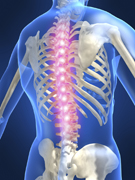 Back Pain is something that affects way too many people these days! According to the American Chiropractic Association, back pain is the fifth most common reason for all physician visits in the US, and the most frequent cause of activity limitation in people younger than 45 years old.
Back Pain is something that affects way too many people these days! According to the American Chiropractic Association, back pain is the fifth most common reason for all physician visits in the US, and the most frequent cause of activity limitation in people younger than 45 years old.
In fact according to the AMA, 70 to 85 percent of all people have back pain at some time in their life. Yikes, what a staggeringly high number of people, and I suspect that unfortunately, these numbers are probably going up rather than down!
As one of those in this majority, who suffers with congenital back issues, I have spent most of my life actively doing things to help keep my body strong, fit, and flexible. I have discovered over the years, that there are some things my body loves to do, and other things that are guaranteed to cause me grief. And what I have learned is that the more I exercise and stay active, generally, the better my back feels, and the happier and healthier my whole-body is.
Let’s face it, when your body hurts, it’s under stress. While some muscle tension is good and appropriate to maintain posture and help us move around, overly tight muscles create unnecessary stress and too much tension which unfortunately can lead to back pain. When any of the bones in our body are held too tightly together by muscle contraction, or misalignment, freedom of movement will be restricted and over time, with the inability to enjoy free and easy movement, poor posture and pain can be the result. It’s no secret that stress causes tension…
Discover how to reduce neck pain, and back pain with Pilates breathing techniques.
Learning effective breathing techniques can be one of the easiest and most effective ways to begin releasing stress and mobilizing the spine without big, dramatic movement or specific back-care exercises. Whether back pain bothers your lower, middle, or upper back and neck – learning how to lengthen and support the back, AND breathe is a great exercise that can be practiced anytime and anywhere to help release stress and reduce pain.
While it’s always best to consult your physician if you’re experiencing any pain or injury, breathing is still required to stay alive! And there are lots of different ways to breathe. When your body is in pain, it will resort to an instinctual pattern that is shallow and will help you turn over just enough oxygen to keep all systems functioning to keep you alive.
While this is practically helpful to be able to get through the day, it may not help solve the bigger issues at hand.
Pilates posterio-lateral breathing is an excellent choice to benefit back care. This is a big fancy word for breathing into the back (posterio) and sides (lateral) of the ribcage. Under the ribcage are the lungs which fill with air on every inhale. Not only does the ribcage help to protect our lungs and other internal organs, but each rib attaches to the spine. As we inhale, and fill our lungs with air, each rib should lift and separate creating space and length through the back of the body (basically stretching the spine!) As the ribs separate, since they are attached to each segment of the spine(vertebrae) , the segments are pulled apart too.
Because I’m personally prone to both lower back and neck issues, I like to take the practice of my posterio-lateral breathing and carry it the full length of my spine so I can feel my inhale lengthen down through my tailbone, and up through the top of my head. It feels slightly different when I’m seated, standing, or laying down, so I’ve got lots of different places to practice throughout the day. I find that lots of times my inhale tends to stop at my shoulders and my head actually jams down on my neck – No wonder it hurts! Feeling the head float off the neck on an inhale is very liberating for releasing tension.
Good breathing habits provide compression and decompression for the spine. Inhale and the vertebrae lift apart – decompression. Exhale and the vertebrae come closer together – compression. This rhythmic action should be happening with every breath we take, all day long to provide a pumping action for vital nutrients and fluids to move up and down the spinal column. When we experience an injury, accident, or back pain for any reason, there may be one, two, or multiple segments restricted from this natural movement. This tension of our bones being held too tightly together, and lack of freedom to move for decompression and compression during breathing, and daily life activities, may, over time result in a chronic back pain problem.
Practicing better breathing habits may not solve all your back pain issues, but it’s certainly a great place to start, and will assist you with good movement and muscle use while you incorporate the most appropriate back-care exercises into your daily routine to keep your body healthy and pain-free.
Discover helpful tips and techniques for Pilates posterior-lateral Breathing Exercises here:
http://www.centerworks.com/blog/2005/10/10/breathing-basics/


I’ve dealt with lower back issues since I was 13. I’m now 26 and have never considered breathing to help me with my problem, so I am very grateful for your post!! Thank you for sharing. I work with a program called Chef’s Diet, and we specialize in creating healthy meals, made from fresh produce and lean meats on a daily basis that are delivered to your door! I myself have benefited from the meals, and maybe you can too :). If you’d like to know more about us, please visit http://www.mychefsdiet.com.
Just imagine I read it twice. While I am not as proficient on this subject, I tally with your closings because they make sense. Thanks and goodluck to you.
This information is good. I get additional knowledge from visiting this site. I will return, if there is an update of information on this site. thanks
My Pilates instructor recommends new students with back pain to invest in blood flow stimulation. And I worked for me. No problem. http://www.kingbrand.com/Back_Injury_Treatment.php?REF=Boris101
Hope it helps.